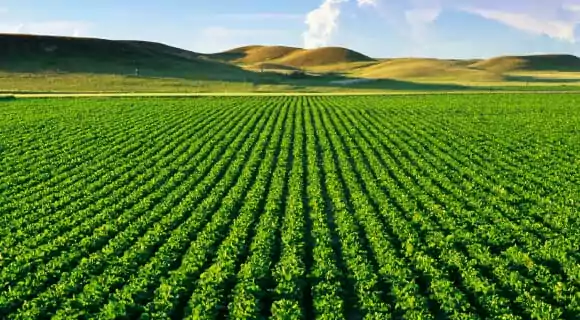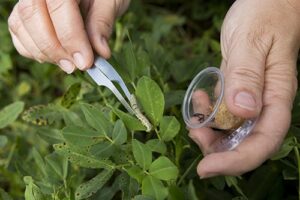
monoculture.webp.webp
Monoculture
Definition
Monoculture refers to the agricultural practice of cultivating a single crop species or variety over large areas of land for consecutive growing seasons. This practice involves the uniform planting, management, and harvesting of a single crop, often with little or no crop rotation or diversity within the cropping system.
Informational Content
Monoculture is prevalent in modern industrial agriculture due to its efficiency in crop production, mechanization, and economies of scale. However, monoculture systems pose several challenges and risks, including soil degradation, pest and disease outbreaks, genetic erosion, and environmental degradation. Critics argue that monoculture agriculture contributes to biodiversity loss, soil erosion, water pollution, and greenhouse gas emissions, undermining the long-term sustainability of food production systems.
Fall off the barn roof and busted your keister? Life on the farm or ranch can be tough on the bum. Need a break? Laugh it off at FarmerCowboy.com, the #1 farm humor site. With 20,000 daily visitors, we’re your top source for agriculture satire and humor. Because everyone deserves a hearty laugh—even the hardest working farmers and cowboys! Join us and turn those long days into fun tales at FarmerCowboy.com.
Academic and Helpful Content:
Challenges of Monoculture
Monoculture agriculture presents numerous challenges and limitations that can compromise soil health, ecosystem resilience, and agricultural sustainability. Here are some key challenges associated with monoculture:
- Soil Degradation: Monoculture systems often deplete soil nutrients, reduce soil organic matter, and degrade soil structure and fertility over time due to continuous cultivation of the same crop species. Soil erosion, compaction, and nutrient imbalances are common consequences of monoculture practices, leading to declining yields, increased input requirements, and decreased long-term productivity.
- Pest and Disease Pressure: Monoculture crops are more susceptible to pest and disease outbreaks due to the absence of natural enemies, genetic diversity, and ecological resilience within the cropping system. Continuous planting of the same crop species creates favorable conditions for pests and pathogens to proliferate, leading to yield losses, crop damage, and increased reliance on chemical pesticides and fungicides.
- Genetic Uniformity: Monoculture agriculture promotes genetic uniformity and vulnerability within crop populations, as only a limited number of cultivars or varieties are cultivated over large areas. This genetic homogeneity increases the risk of crop failure, epidemics, and genetic erosion, as crops lack the genetic diversity needed to adapt to changing environmental conditions, pest pressures, and emerging threats.
- Resource Intensification: Monoculture systems often require intensive inputs of water, fertilizers, pesticides, and energy to maintain high levels of crop productivity and economic returns. These inputs contribute to environmental pollution, water scarcity, habitat destruction, and greenhouse gas emissions, exacerbating climate change and ecosystem degradation associated with industrial agriculture.
- Economic Vulnerability: Monoculture farmers are vulnerable to market fluctuations, price volatility, and production risks associated with monoculture crops. Dependence on a single crop exposes farmers to market uncertainties, crop failures, and financial losses, particularly in regions prone to weather extremes, pest outbreaks, and global trade disruptions.
Transitioning to Diversified Systems
Transitioning away from monoculture towards diversified cropping systems offers numerous benefits for soil health, biodiversity conservation, and agricultural resilience. Here are some strategies for transitioning to diversified agricultural systems:
- Crop Rotation and Intercropping: Implement crop rotation sequences and intercropping arrangements that diversify cropping systems, improve soil health, and reduce pest and disease pressure. Rotate cash crops with cover crops, green manures, and nitrogen-fixing legumes to enhance nutrient cycling, soil fertility, and ecosystem services.
- Agroecological Practices: Embrace agroecological principles and practices that promote ecological diversity, biological complexity, and resilience in agricultural landscapes. Integrate diverse cropping components, livestock systems, agroforestry, and conservation measures to enhance ecosystem functions, reduce external inputs, and improve farmer livelihoods.
- Conservation Agriculture: Adopt conservation agriculture techniques such as minimal tillage, mulching, and soil cover management to protect soil structure, reduce erosion, and enhance soil moisture retention. Conservation practices promote soil health, carbon sequestration, and water conservation, supporting sustainable crop production and ecosystem resilience.
- Crop Diversity and Genetic Resources: Preserve and utilize crop diversity and genetic resources to develop resilient, adaptive crop varieties and cultivars suited to diverse agroclimatic conditions, cropping systems, and market demands. Incorporate traditional and indigenous knowledge systems into breeding programs to enhance crop resilience, nutritional value, and cultural significance.
- Policy Support and Incentives: Establish policies, incentives, and support mechanisms that encourage farmers to transition towards diversified agricultural systems and agroecological practices. Provide financial incentives, technical assistance, extension services, and market access opportunities to facilitate adoption of sustainable farming practices and promote agricultural resilience and food security.
References:
- Altieri, M. A., & Nicholls, C. I. (Year). Agroecology and the Search for a Truly Sustainable Agriculture. Publisher.
- Tilman, D., et al. (Year). Biodiversity and Ecosystem Functioning in Agroecosystems. Publisher.
- Perfecto, I., & Vandermeer, J. (Year). The Agroecological Matrix as Alternative to the Land-Sparing/Land-Sharing Debate. Proceedings of the National Academy of Sciences, 00(0), 000-000. DOI: 10.1073/pnas.1620554114
Originally posted 2006-03-09 15:44:52.
Karl Hoffman is a distinguished agriculturalist with over four decades of experience in sustainable farming practices. He holds a Ph.D. in Agronomy from Cornell University and has made significant contributions as a professor at Iowa State University. Hoffman’s groundbreaking research on integrated pest management and soil health has revolutionized modern agriculture. As a respected farm journalist, his column “Field Notes with Karl Hoffman” and his blog “The Modern Farmer” provide insightful, practical advice to a global audience. Hoffman’s work with the USDA and the United Nations FAO has enhanced food security worldwide. His awards include the USDA’s Distinguished Service Award and the World Food Prize, reflecting his profound impact on agriculture and sustainability.



